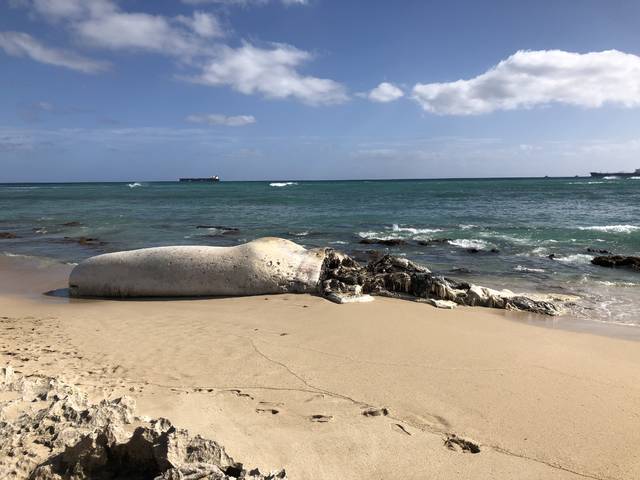Decomposing whale towed out to sea returns to shore again


TYNE PHILLIPS / TPHILLIPS@STARADVERTISER.COM
About two-thirds of the sperm whale was still intact Saturday and the stench could be detected from Barbers Point Beach Park. Officials with the University of Hawaii’s stranding lab were on the scene to collect samples to help them better understand sperm whales.

TYNE PHILLIPS / TPHILLIPS@STARADVERTISER.COM
This is the same sperm whale that washed ashore at the Sand Island State Recreation Area two weeks ago.



The decomposing sperm whale carcass that just won’t go away is continuing to make a nuisance of itself, this time washing ashore near Campbell Industrial Park.
The carcass was first reported Jan. 10 about a mile from Kewalo Basin with a number of large tiger sharks feeding on it. After drifting into shallow waters fronting the Sand Island State Recreation Area, city, state and federal agencies towed the whale into the deep ocean 15 miles off Oahu’s south shore on Jan. 12.
The remains made international headlines when dive tour operator Ocean Ramsey posted photos and video of herself swimming with a massive great white shark that was attracted by the carcass. Other people were photographed standing on the floating hulk.
About two-thirds of the whale was still intact when reported Saturday near the industrial park, and the stench wafted to Barbers Point Beach Park.
Officials with the University of Hawaii’s stranding lab were on the scene collecting samples to help better understand the species, the largest of the toothed whales.
“Our team is just gonna take advantage of the fact that we have an opportunity to learn about sperm whales through that process,” said Kristi West.
Don't miss out on what's happening!
Stay in touch with breaking news, as it happens, conveniently in your email inbox. It's FREE!
After inspecting the contents of the whale’s stomach, West said the marine mammal hadn’t eaten much before its death.
Meanwhile, it wasn’t clear how the carcass would be handled. “All involved agencies are aware of this and we’ll have more info next week,” said Dan Dennison, senior communications manager for the Hawaii Department of Land and Natural Resources, in an email Saturday.
West advised the public to stay out of the water in the area due to the possible presence of sharks and the potential for diseases from the bacteria on the decomposing whale.




